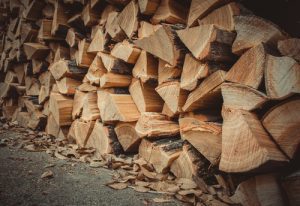Termites In Firewood
By Chris Williams on January 24, 2012.
Q. My husband recently brought firewood into our basement, and basically filled up one whole side of it. There is enough wood to last all winter but I am worried that he may have brought termites into our home. Is it possible to bring termites in with firewood, and should I be concerned?
A. Fire wood being stored inside is common in New England, as retrieving it from under snow and during inclement weather is a hassle. While firewood may contain certain insects, termites should not be an issue. Termite colonies live in the soil and feed on wood that they find within their foraging territory. If termites were feeding on the firewood outside, it may be possible to bring some of the workers in with the wood(workers find food, build tunnels, and feed the colony). Workers feeding inside firewood will eventually die without contact with the colony, as well as from desiccation due to lack of moisture. Firewood may serve as food for termites if they find it within the house. If foraging termites locate wood near a joint or crack in the foundation they will feed on it.
Fire wood may harbor spiders, beetles, centipedes, wood roaches, pseudo scorpions, certain wasp species, and carpenter ants. Spiders and carpenter ants would be the biggest concern, followed by powder post beetles. Carpenter ant colonies may reside within wood stored outside, and may be transported inside. If the colony was in hibernation, they will “wake up” in the warm basement and may move into the house. Spiders hiding in firewood will also become active and search for food. Many species of beetles, including powder post beetles, live in wood. Some beetle species prefer living trees, others prefer aged wood. Depending on the type of wood and moisture content, beetles located within the firewood may continue to develop and emerge within the home. In most cases a beetle hatch from firewood is a one time event, although large numbers may emerge. Beetles will die quickly once emerging, and will not usually infest a home. Powder post beetles may infest wood in damp basements and do cause structural damage if not controlled. Severe damage takes years to occur.
 I do have recommendations to consider when bringing wood into a home. Firstly, inspect the wood as it goes in. Look for obvious signs of insect activity such as live ants, conspicuous holes, sawdust or powder falling from holes in the wood. Banging it on something may dislodge spiders and insects hiding on the wood or in the bark. If something looks suspicious burn or discard it. Termites feeding on the wood may also be visible, usually in wood that was stored directly on the ground. Termites are relatively small, whitish insects, and are always associated with soil or mud used to created tunnels and hold moisture. Termites will die eventually without moisture and contact with their colony.
I do have recommendations to consider when bringing wood into a home. Firstly, inspect the wood as it goes in. Look for obvious signs of insect activity such as live ants, conspicuous holes, sawdust or powder falling from holes in the wood. Banging it on something may dislodge spiders and insects hiding on the wood or in the bark. If something looks suspicious burn or discard it. Termites feeding on the wood may also be visible, usually in wood that was stored directly on the ground. Termites are relatively small, whitish insects, and are always associated with soil or mud used to created tunnels and hold moisture. Termites will die eventually without moisture and contact with their colony.
As the wood is stacked inside, be sure to keep it up off the floor. This will discourage foraging termites from locating the wood inside the house. Termites would need to build visible mud tubes from a crack or joint to the wood. Make an effort to bring in only enough wood for the winter. Wood piles that sit for years aging inside should be discouraged. Once the wood is stacked, inspect it periodically for signs of insects, such as sawdust piles, small piles of powder, and live or dead insects in the area. Wood that is suspect may be burned or discarded outside. Treating firewood with pesticides is not necessary, and should never be done due to the risk of contacting toxic compounds in the smoke. The area around the wood stack may be treated to minimize insect or spider activity coming from the wood. If you think you have a pest control issue related to firewood, contact a Pest Control Professional for a positive identification of the suspect pest, and specific recommendations for control measures or other remediation tactics.